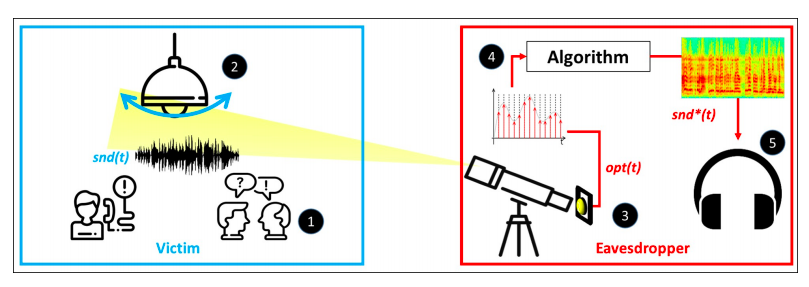Man
Professional
- Messages
- 3,222
- Reaction score
- 986
- Points
- 113

Scientists from the National University of Singapore have discovered a way to detect sounds in a room using a robot vacuum cleaner. However, the vacuum cleaner that the experts tested does not have a built-in microphone. The eavesdropping principle is slightly different - a lidar is used instead of a microphone.

In the diagram, the lidar intercepts data during a user conference
The lidar consists of two elements: a laser emitter and a receiver. The lidar measures the distance to objects with high accuracy using a laser beam. And, as it turns out, with the help of a laser, you can perfectly hear everything that happens around the spy robot.
What is the essence of the experiment? A vacuum cleaner was installed next to a trash can. A lidar was aimed at the can. An audio speaker was installed 20 cm from the can, which reproduced sound at a volume of about 70 dB. As a result of using specialized equipment, the researchers were able to not only eavesdrop on the sound. As it turned out, this technology allows:
- with 96% - determine the gender of the speaker,
- with 91% - to restore the spoken numbers,
- with 90% - identify musical intros (selected from 10 probable ones),
- with 67.5% - identify the identity of people speaking in the room (also a sample of 10 possible).

How does a lidar work?
How does it record? The lidar rotates at a frequency of 5 Hz, recording 360 distance values per revolution. But this recording frequency is not enough. Scientists have modified the electrical circuit in the device unit so that it records the distance without rotation. Under such conditions, the recording frequency increases 360 times to 1.8 kHz.
What's next? Then the data is filtered. Empty fragments that remain when the beam does not return are recognized. Low-frequency noise is also discarded and sound in low frequencies is amplified. The resulting signal is processed by neural network algorithms.

The convolutional neural network classifies sounds into known classes. The engineers trained it on an open database, Free Spoken Digit, as well as on their own selection of YouTube music videos.
What other methods exist?

Screenshot of a recording with a scheme for restoring sound from a bag of chips
Several years ago, scientists from the Massachusetts Institute of Technology demonstrated how sound can be restored in the most unexpected ways. In one case, they restored the melody of a houseplant. And in another experiment, they filmed and restored the audio sounding next to a bag of chips. They managed to transform the sound using a high-speed camera: by changing the pixels in the image of the object being filmed.

Lamphone System
This summer, scientists in Israel eavesdropped on speech in a house in real time, using vibrations from a light bulb. The method was called Lamphone. This requires a telescope with a photodiode connected to it. An optical receiver converts the light falling on it into an electrical signal. Using an algorithm, the signal is converted into a speech spectogram, from which the speech of the interlocutors is extracted.
Source
